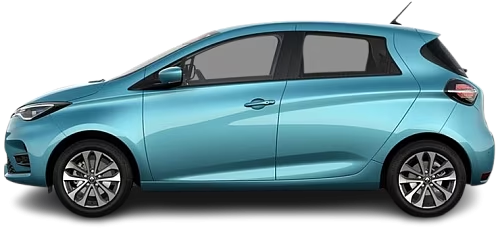USA EV Comparison: Kia Niro EV Standard Range vs Renault Zoe Z.E. 50 R135
Struggling to Decide? Let AI Help!
Your AI Summary Is Ready!
General Info
Both vehicles have been discontinued and were never available for sale in the United States.
The Kia Niro EV Standard Range (2019-2022) is a SUV, whereas the Renault Zoe Z.E. 50 R135 (2019-2024) is a Hatchback.
| Property | Kia Niro EV Standard Range | Renault Zoe Z.E. 50 R135 |
|---|---|---|
| Years of Production | 2019-2022 | 2019-2024 |
| Current Status | Discontinued | Discontinued |
| Country of Manufacture | South Korea | France |
| Body Style | SUV | Hatchback |
| Market Availability | EU | EU |
| GCC Score | 5.2 | 5.6 |
Range and Efficiency
With identical energy efficiency, Renault Zoe Z.E. 50 R135 (2019-2024) outpaces Kia Niro EV Standard Range (2019-2022) in real-world range thanks to its bigger battery.
| Property | Kia Niro EV Standard Range | Renault Zoe Z.E. 50 R135 |
|---|---|---|
| Range (WLTP) | 180 mi | 239 mi |
| Range (GCC) | 153 mi | 203 mi |
| Battery Capacity (Nominal) | 42 kWh | 54.7 kWh |
| Battery Capacity (Usable) | 39.2 kWh | 52 kWh |
| Efficiency per 100 mi | 25.6 kWh/100 mi | 25.6 kWh/100 mi |
| Efficiency per kWh | 3.9 mi/kWh | 3.9 mi/kWh |
| Range and Efficiency Score | 5.8 | 6.5 |
Charging
Both vehicles utilize a standard 400-volt architecture.
The Renault Zoe Z.E. 50 R135 (2019-2024) offers faster charging speeds at DC stations, reaching up to 50 kW, while the Kia Niro EV Standard Range (2019-2022) maxes out at 44 kW.
The Renault Zoe Z.E. 50 R135 (2019-2024) features a more powerful on-board charger, supporting a maximum AC charging power of 22 kW, whereas the Kia Niro EV Standard Range (2019-2022) is limited to 7.2 kW.
| Property | Kia Niro EV Standard Range | Renault Zoe Z.E. 50 R135 |
|---|---|---|
| Max Charging Power (AC) | 7.2 kW | 22 kW |
| Max Charging Power (DC) | 44 kW | 50 kW |
| Architecture | 400 V | 400 V |
| Charge Port | CCS Type 2 | CCS Type 2 |
| Charging Score | 4 | 6.9 |
Performance
Both vehicles are front-wheel drive.
Both cars offer the same motor power, but the Renault Zoe Z.E. 50 R135 (2019-2024) achieves a faster 0-60 mph time.
| Property | Kia Niro EV Standard Range | Renault Zoe Z.E. 50 R135 |
|---|---|---|
| Drive Type | FWD | FWD |
| Motor Type | PMSM | EESM |
| Motor Power (kW) | 100 kW | 100 kW |
| Motor Power (hp) | 134 hp | 134 hp |
| Motor Torque | 291 lb-ft | 181 lb-ft |
| 0-60 mph | 9.5 s | 9.1 s |
| Top Speed | 96 mph | 87 mph |
| Performance Score | 3.1 | 2.5 |
Dimensions
The Kia Niro EV Standard Range (2019-2022) is longer, but has a similar width and height to the Renault Zoe Z.E. 50 R135 (2019-2024).
The Kia Niro EV Standard Range (2019-2022) boasts a more extended wheelbase.
| Property | Kia Niro EV Standard Range | Renault Zoe Z.E. 50 R135 |
|---|---|---|
| Length | 172.2 in | 160.9 in |
| Width (with Mirrors) | - Width (with Mirrors) | 76.6 in |
| Width (w/o Mirrors) | 71.1 in | 70.4 in |
| Height | 61.4 in | 61.5 in |
| Wheelbase | 106.3 in | 101.9 in |
Cargo and Towing
The Kia Niro EV Standard Range (2019-2022) provides more cargo capacity, featuring both a larger trunk and more space with the rear seats folded.
Neither car is equipped with a frunk (front trunk).
Neither vehicle is officially rated for towing in the US.
| Property | Kia Niro EV Standard Range | Renault Zoe Z.E. 50 R135 |
|---|---|---|
| Number of Seats | 5 | 5 |
| Curb Weight | 3629 lb | 3477 lb |
| Cargo Volume (Trunk) | 18.5 ft3 | 11.9 ft3 |
| Cargo Volume (Max) | 53 ft3 | 43.3 ft3 |
| Cargo Volume (Frunk) | - Cargo Volume (Frunk) | - Cargo Volume (Frunk) |
| Towing Capacity | - Towing Capacity | - Towing Capacity |
| Cargo and Towing Score | 5.5 | 4.2 |




